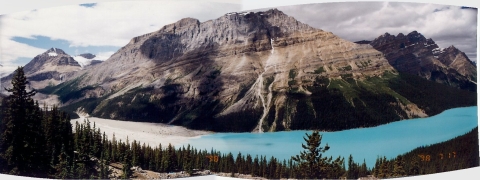What is the colour of water?
What is the colour of water?
LI Sun-wai
What is the colour of water?
This question has different answers from different experts over various times. Physically, the colour of water is affected by factors like the light source, absorption and scattering of light, as well as suspended materials in the water. The major light source in the Earth is the Sun. Sunlight comprises different colours of light, from red light with the longest wavelength to violet light with the shortest. The colour of an object mainly depends on the colour of light emitted from it.
Absorption by water is stronger for red light, but weaker for blue light. But this effect is only apparent when the water is reasonably thick (exceeding 1 metre). This is why, in daily life, a cup of pure water appears colourless under white light whereas a big aquarium looks bluish through the thickness of water.
Why is the colour of large water bodies, like the sea and lakes, blue?
Have you noticed the changes in the colour of the sea when you go to the seaside? Under different weather conditions, the colour of the sea changes with the time, the viewing angle and the height. The sea appears blue under a clear sky because the blue light from the sky is reflected by the water surface. Also sea water absorbs red light and scatters blue light. These factors work together to give the sea a bluish look.
What colour do we see under the sea?
Absorption is the most important factor affecting the colour seen under the sea. Red light becomes weaker with depth because it is absorbed most. On the other hand, water scatters blue light. Thus we see blue colour. As we go deeper, the overall light intensity decreases and it becomes totally dark eventually.
Furthermore, salt in the sea water enhances scattering of light. However, the concentration of salt in sea water is normally too low to show any noticeable effect.
Why do some seas, lakes and rivers have special colours different from normal water bodies?
Suspended material affects the colour of water in seas, lakes and rivers. Sea water will appear green when it contains large amounts of green algae. If the algae are red, the sea water will turn red. This is what we call "red tide". The Yellow River in Mainland carries a large amount of mud from the Loess Plateau. The mud gives the river a yellow look, hence its namesake.
Most lakes in the Canadian Rockies are aquamarine in colour (Figure 1). It is because of the powder produced when the glacier grinds over rocks in its path. The fine powder suspended in lake water enhances the scattering of light, making the water as a whole brighter as more of the incoming light returns from it. Furthermore, because of the large amount of particles in the water, it takes a shorter distance for the sunlight to be scattered and to leave the water. Absorption of red light is thus less, shifting the original blue colour towards green.

Figure 1: Aquamarine lakes in Canadian Rockies
References:
[1] "Clouds in a glass of beer",C.F. Bohren,Dover Publications,2001。
[2] https://www.answers.com/topic/rock-flour
[3] https://baike.baidu.com/view/4479.htm
[1] "Clouds in a glass of beer",C.F. Bohren,Dover Publications,2001。
[2] https://www.answers.com/topic/rock-flour
[3] https://baike.baidu.com/view/4479.htm